| Pages:
1
2
3
4
5 |
TheMrbunGee
Hazard to Others
  
Posts: 364
Registered: 13-7-2016
Location: EU
Member Is Offline
Mood: Phosphorising
|
|
Quote: Originally posted by RocksInHead  | | This is kind of a long shot (considering it is crystaline) but it might be sodium carbonate maybe? Seeing how you added the CuSO4 and got a green
insoluble salt it may have been Na2CO3, considering that Cu3(OH)2(CO3)2 is greenish blue. |
Wouldn't sodium carbonate react with acids? 
|
|
|
Neme
Hazard to Self
 
Posts: 86
Registered: 28-5-2016
Location: Czech republic
Member Is Offline
Mood: No Mood
|
|
Quote: Originally posted by TheMrbunGee  | Quote: Originally posted by RocksInHead  | | This is kind of a long shot (considering it is crystaline) but it might be sodium carbonate maybe? Seeing how you added the CuSO4 and got a green
insoluble salt it may have been Na2CO3, considering that Cu3(OH)2(CO3)2 is greenish blue. |
Wouldn't sodium carbonate react with acids?  |
Yep, it would...
Could you please do test with Ca2+?
|
|
|
TheMrbunGee
Hazard to Others
  
Posts: 364
Registered: 13-7-2016
Location: EU
Member Is Offline
Mood: Phosphorising
|
|
I added mystery solution to CaCl2 solution and after a second - white insoluble precipitate appeared.
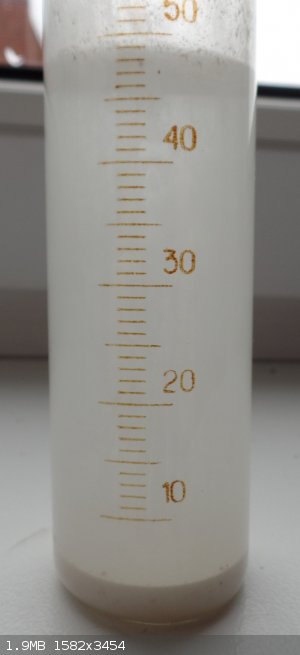
[Edited on 28-7-2016 by TheMrbunGee]
|
|
|
Neme
Hazard to Self
 
Posts: 86
Registered: 28-5-2016
Location: Czech republic
Member Is Offline
Mood: No Mood
|
|
I have had suspicion that it could be phosphate group, this would totally agree. Are you able to perform any other test for phosphates?
PS: Maybe test for arsenate would be an option if the mysterious solution reveals itself as phosphateless.
|
|
|
RocksInHead
Harmless

Posts: 39
Registered: 16-6-2016
Member Is Offline
Mood: Highly Nitrated
|
|
Quote: Originally posted by TheMrbunGee  | Quote: Originally posted by RocksInHead  | | This is kind of a long shot (considering it is crystaline) but it might be sodium carbonate maybe? Seeing how you added the CuSO4 and got a green
insoluble salt it may have been Na2CO3, considering that Cu3(OH)2(CO3)2 is greenish blue. |
Wouldn't sodium carbonate react with acids?  |
OH MY GOD I AM AN IDIOT.
|
|
|
Neme
Hazard to Self
 
Posts: 86
Registered: 28-5-2016
Location: Czech republic
Member Is Offline
Mood: No Mood
|
|
Quote: Originally posted by Neme  | I have had suspicion that it could be phosphate group, this would totally agree. Are you able to perform any other test for phosphates?
PS: Maybe test for arsenate would be an option if the mysterious solution reveals itself as phosphateless. |
Ummm, I'm wondering if you really could have access to sodium arsenate. Maybe just ignore that as an option.
|
|
|
DraconicAcid
International Hazard
    
Posts: 4278
Registered: 1-2-2013
Location: The tiniest college campus ever....
Member Is Offline
Mood: Semi-victorious.
|
|
Quote: Originally posted by Neme  | Quote: Originally posted by Neme  | I have had suspicion that it could be phosphate group, this would totally agree. Are you able to perform any other test for phosphates?
PS: Maybe test for arsenate would be an option if the mysterious solution reveals itself as phosphateless. |
Ummm, I'm wondering if you really could have access to sodium arsenate. Maybe just ignore that as an option. |
But doing the Marsh test for arsenic would be so much fun!
Please remember: "Filtrate" is not a verb.
Write up your lab reports the way your instructor wants them, not the way your ex-instructor wants them.
|
|
|
TheMrbunGee
Hazard to Others
  
Posts: 364
Registered: 13-7-2016
Location: EU
Member Is Offline
Mood: Phosphorising
|
|
Quote: Originally posted by Neme  | I have had suspicion that it could be phosphate group, this would totally agree. Are you able to perform any other test for phosphates?
PS: Maybe test for arsenate would be an option if the mysterious solution reveals itself as phosphateless. |
Test with (NH4)6Mo7O24 showed that it is not phosphate nor arsenate. :/
|
|
|
DraconicAcid
International Hazard
    
Posts: 4278
Registered: 1-2-2013
Location: The tiniest college campus ever....
Member Is Offline
Mood: Semi-victorious.
|
|
Might be oxalate.
Please remember: "Filtrate" is not a verb.
Write up your lab reports the way your instructor wants them, not the way your ex-instructor wants them.
|
|
|
TheMrbunGee
Hazard to Others
  
Posts: 364
Registered: 13-7-2016
Location: EU
Member Is Offline
Mood: Phosphorising
|
|
It does not decompose @ 260C. :?
|
|
|
Neme
Hazard to Self
 
Posts: 86
Registered: 28-5-2016
Location: Czech republic
Member Is Offline
Mood: No Mood
|
|
Quote: Originally posted by TheMrbunGee  | Quote: Originally posted by Neme  | I have had suspicion that it could be phosphate group, this would totally agree. Are you able to perform any other test for phosphates?
PS: Maybe test for arsenate would be an option if the mysterious solution reveals itself as phosphateless. |
Test with (NH4)6Mo7O24 showed that it is not phosphate nor arsenate. :/
|
Wow, I'm getting out of ideas, could you try some tests with cationts? e.g. Fe2+, Fe3+, or even Ag+ if you have some silver nitrate you could spare.
|
|
|
TheMrbunGee
Hazard to Others
  
Posts: 364
Registered: 13-7-2016
Location: EU
Member Is Offline
Mood: Phosphorising
|
|
Quote: Originally posted by Neme  |
Wow, I'm getting out of ideas, could you try some tests with cationts? e.g. Fe2+, Fe3+, or even Ag+ if you have some silver nitrate you could spare.
|
With FeCl3 /FeCl2 (Oxidized FeCl2).
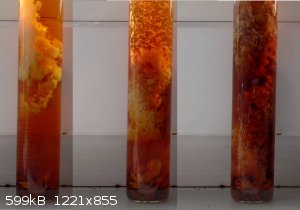
I will now try to isolate silver nitrate from the solution I got from dissolving piece of silver in nitric acid, but it had copper in it, so it
won’t work for this test. That is coming soon.
[Edited on 30-7-2016 by TheMrbunGee]
|
|
|
Neme
Hazard to Self
 
Posts: 86
Registered: 28-5-2016
Location: Czech republic
Member Is Offline
Mood: No Mood
|
|
I'm sorry, even after lot of searching the net I don't really have a clue.
|
|
|
Metallus
Hazard to Others
  
Posts: 116
Registered: 16-5-2013
Member Is Offline
Mood: No Mood
|
|
"snip"
Is it soluble in Ethanol?
[Edited on 1-8-2016 by Metallus]
|
|
|
Neme
Hazard to Self
 
Posts: 86
Registered: 28-5-2016
Location: Czech republic
Member Is Offline
Mood: No Mood
|
|
I think he said it's inorganic.
|
|
|
Metallus
Hazard to Others
  
Posts: 116
Registered: 16-5-2013
Member Is Offline
Mood: No Mood
|
|
You are right. I'll give it another shot then, even though there are very few alternatives, considering the most common anions.
You tested it with molybdate to see if it was phosphate but the test was negative. I've only worked with molybdates in a couple of occasions, but what
if this was the molybdate? Highly soluble in water, not much big of reaction in those environments... What if you add your salt to an acidified
solution of sugar or some other reducing agent?
|
|
|
TheMrbunGee
Hazard to Others
  
Posts: 364
Registered: 13-7-2016
Location: EU
Member Is Offline
Mood: Phosphorising
|
|
Quote: Originally posted by Metallus  |
You are right. I'll give it another shot then, even though there are very few alternatives, considering the most common anions.
You tested it with molybdate to see if it was phosphate but the test was negative. I've only worked with molybdates in a couple of occasions, but what
if this was the molybdate? Highly soluble in water, not much big of reaction in those environments... What if you add your salt to an acidified
solution of sugar or some other reducing agent?
|
You might be on to something! I added sodium phosphate and nitric acid to the salt and got nice yellow color of Phosphomolybdate. (picture)
sugar, nitric acid, water and salt x did not do anything, did I had to add water?
wiki says that Na molybdate would react explosively with molten Mg, I mixed the salt with Mg powder and heated the mixture - got no reaction at all.
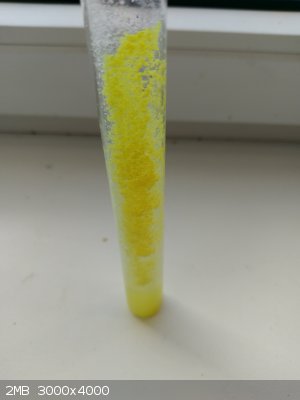
Also after heating the xsalt, sugar water and nitric acid mixture something yellowish precipitated and blue spots apeared on the walls of test tube.
[Edited on 2-8-2016 by TheMrbunGee]
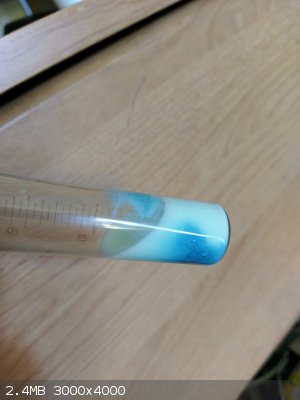 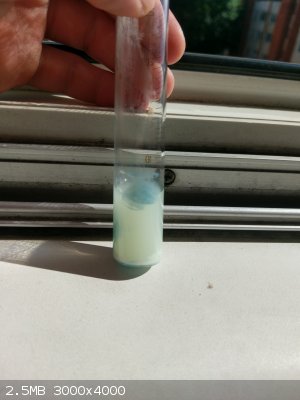
[Edited on 2-8-2016 by TheMrbunGee]
|
|
|
Metallus
Hazard to Others
  
Posts: 116
Registered: 16-5-2013
Member Is Offline
Mood: No Mood
|
|
| Quote: | You might be on to something! I added sodium phosphate and nitric acid to the salt and got nice yellow color of Phosphomolybdate. (picture)
sugar, nitric acid, water and salt x did not do anything, did I had to add water?
wiki says that Na molybdate would react explosively with molten Mg, I mixed the salt with Mg powder and heated the mixture - got no reaction at all.
|
Have you heated the molybdate/sugar solution? Alternatively you can also try to add a reducing agent to the yellow suspension you've obtained when you
added phosphate (for phosphate tests, stannous chloride is often employed; it'll be like doing an inverse phosphate test).
[Edited on 2-8-2016 by Metallus]
|
|
|
Metallus
Hazard to Others
  
Posts: 116
Registered: 16-5-2013
Member Is Offline
Mood: No Mood
|
|
Reduction of molybdates should yield molybdenum blue, but I can't understand well the yellow part. Also, about the texture of your solution, how much
sugar did you add? I fear that the yellow tint might be due to HNO3 oxidizing sugar. You could try to repeat this test with a non-oxidizing acid like
HCl or keep the HNO3 medium and use a different reductant.
Moreover, as you said before, molybdates should react if you heat it with magnesium or zinc but you said that nothing happened. On the other hand,
tungstates have similar reactions to molybdates but I only worked with WO3 once, so my experience with tungstates is close to nil. I've just read a
few tests to perform on tungstates that require thiocyanate and SnCl2. Do you have access to them? I've checked all the other reactions that you
listed, and they are all compatible with both molybdates and tungstates to a good extent (even the precipitation of copper).
Oh ye, is the salt... heavy?
Nice pictures btw.
|
|
|
TheMrbunGee
Hazard to Others
  
Posts: 364
Registered: 13-7-2016
Location: EU
Member Is Offline
Mood: Phosphorising
|
|
Quote: Originally posted by Metallus  | Reduction of molybdates should yield molybdenum blue, but I can't understand well the yellow part. Also, about the texture of your solution, how much
sugar did you add? I fear that the yellow tint might be due to HNO3 oxidizing sugar. You could try to repeat this test with a non-oxidizing acid like
HCl or keep the HNO3 medium and use a different reductant.
Moreover, as you said before, molybdates should react if you heat it with magnesium or zinc but you said that nothing happened. On the other hand,
tungstates have similar reactions to molybdates but I only worked with WO3 once, so my experience with tungstates is close to nil. I've just read a
few tests to perform on tungstates that require thiocyanate and SnCl2. Do you have access to them? I've checked all the other reactions that you
listed, and they are all compatible with both molybdates and tungstates to a good extent (even the precipitation of copper).
Oh ye, is the salt... heavy?
Nice pictures btw. |
Thanks! 
The salt is not extraordinary heavy. :?
My HCl is yellow, because it is old! :/ I have Tin, so I could make SnCl2!
I am now making tin chloride and potassium thiocyanate! Do some of them have to be solids or really pure?
|
|
|
DraconicAcid
International Hazard
    
Posts: 4278
Registered: 1-2-2013
Location: The tiniest college campus ever....
Member Is Offline
Mood: Semi-victorious.
|
|
If it's not soluble in organic solvents, you could determine its density.
Please remember: "Filtrate" is not a verb.
Write up your lab reports the way your instructor wants them, not the way your ex-instructor wants them.
|
|
|
Metallus
Hazard to Others
  
Posts: 116
Registered: 16-5-2013
Member Is Offline
Mood: No Mood
|
|
Quote: Originally posted by TheMrbunGee  | Quote: Originally posted by Metallus  | Reduction of molybdates should yield molybdenum blue, but I can't understand well the yellow part. Also, about the texture of your solution, how much
sugar did you add? I fear that the yellow tint might be due to HNO3 oxidizing sugar. You could try to repeat this test with a non-oxidizing acid like
HCl or keep the HNO3 medium and use a different reductant.
Moreover, as you said before, molybdates should react if you heat it with magnesium or zinc but you said that nothing happened. On the other hand,
tungstates have similar reactions to molybdates but I only worked with WO3 once, so my experience with tungstates is close to nil. I've just read a
few tests to perform on tungstates that require thiocyanate and SnCl2. Do you have access to them? I've checked all the other reactions that you
listed, and they are all compatible with both molybdates and tungstates to a good extent (even the precipitation of copper).
Oh ye, is the salt... heavy?
Nice pictures btw. |
Thanks! 
The salt is not extraordinary heavy. :?
My HCl is yellow, because it is old! :/ I have Tin, so I could make SnCl2!
I am now making tin chloride and potassium thiocyanate! Do some of them have to be solids or really pure?
|
It would have been better if the HCl were a clear solution. Is it as yellow as the product of HNO3/sugar/salt mix? If it's just faintly yellow due to
iron impurities but clearer, I would attempt a quick HCl/sugar/salt mix (HCl 4-5M should suffice. Perhaps first completely dissolve sugar in diluted
HCl, then dump a small quantity of the salt).
The thing is, SnCl2 requires HCl solution in order to not hydrolize and precipitate. If it is too yellow and molybden blue forms, I'd expect a green
product.
Potassium thiocyanate + SnCl2 in HCl is used to extract tungsten compounds because it should form a yellow/greenish complex. Again, if we start
already from a yellow coloration, it might be hard to accurately distinguish the two.
PS: is the pH of the salt solution basic?
|
|
|
TheMrbunGee
Hazard to Others
  
Posts: 364
Registered: 13-7-2016
Location: EU
Member Is Offline
Mood: Phosphorising
|
|
Quote: Originally posted by Metallus  |
It would have been better if the HCl were a clear solution. Is it as yellow as the product of HNO3/sugar/salt mix? If it's just faintly yellow due to
iron impurities but clearer, I would attempt a quick HCl/sugar/salt mix (HCl 4-5M should suffice. Perhaps first completely dissolve sugar in diluted
HCl, then dump a small quantity of the salt).
The thing is, SnCl2 requires HCl solution in order to not hydrolize and precipitate. If it is too yellow and molybden blue forms, I'd expect a green
product.
Potassium thiocyanate + SnCl2 in HCl is used to extract tungsten compounds because it should form a yellow/greenish complex. Again, if we start
already from a yellow coloration, it might be hard to accurately distinguish the two.
PS: is the pH of the salt solution basic? |
At the moment I don’t have anything to test pH. :/
My HCl is even more yellow, then that mixture before. Interesting thing - I added acetic acid to the xsalt and it turned a bit yellow too! :?
Ok, I made some Potassium thiocyanate yesterday and I think some tin has dissolved in HCl, Should I just add them all together?
I added SnCl to the xsolution. Black precipitate formed. And there is some dark yellow/orange solution forming (2nd and 3rd frame) . Potassium
thiocyanate does not change anything. (Picture)
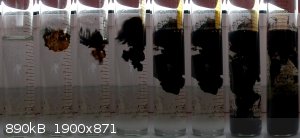
I also dissolved xsalt in my dirty HCl and then added HCl/SnCl2 mixture. Looked like much more orange solution formed. But there was parts of test
tube sides where deep blue color had formed!
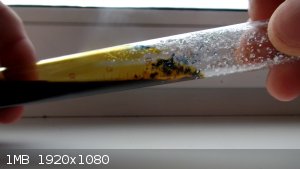
BTW, when I mix SnCl2 with yellow HCl it becomes colorless! 
Last test I just did:
I took HCl and added Potassium thiocyanate to it. (Yellow goes to pink/red) then I added SnCl2 solution (everything becomes clear) and then I added
xsolution (pictures) and I have a orange/red/brown solution.
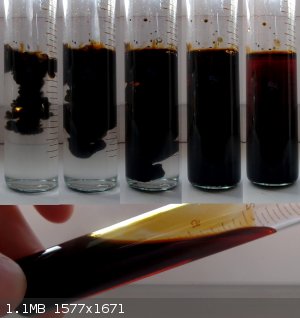
Edit:
I Added much more xsolution to last test result and I got the deep blue molybden blue.  So it is confirmed for molybden. but which one is it.. :? So it is confirmed for molybden. but which one is it.. :?
[Edited on 3-8-2016 by TheMrbunGee]
|
|
|
Metallus
Hazard to Others
  
Posts: 116
Registered: 16-5-2013
Member Is Offline
Mood: No Mood
|
|
So, to sum up:
- Sodium molybdate:
1) 84g/100ml solubility at 100°C (yours was approx 80g/100ml at 95°C)
2) Melts at 687°C (yours melts before that, if you were able to melt it on aluminium foil which supposedly melts at T < 660°C, which leads me to
think it is not pure)
3) reacts with phosphate to form canary yellow complex (yours formed that yellow complex with phosphate)
4) gets reduced to molybdenum blue when reacted with an acid solution of a reductant (yours formed the blue molybden)
5) in the presence of thiocyanate and a reductant, it forms red blood solution (Your solution of HCl and thiocyanate is pink/red at start most likely
because of Fe(III) impurities that form FeSCN2- (red); this disappears when you reduce it with SnCl2. Adding the molybdate then
yields the red/brown color)
6) it is reported in here http://molybdenum.atomistry.com/detection_of_molybdenum.html that reaction with acetic acid yields a yellow coloration (you said that yours turned
yellow) and it also confirms many other reactions that you've carried out (I dont' know how much truthful this page is, but I found most of those
reactions in literature as well).
|
|
|
TheMrbunGee
Hazard to Others
  
Posts: 364
Registered: 13-7-2016
Location: EU
Member Is Offline
Mood: Phosphorising
|
|
Quote: Originally posted by Metallus  | So, to sum up:
- Sodium molybdate:
1) 84g/100ml solubility at 100°C (yours was approx 80g/100ml at 95°C)
2) Melts at 687°C (yours melts before that, if you were able to melt it on aluminium foil which supposedly melts at T < 660°C, which leads me to
think it is not pure)
3) reacts with phosphate to form canary yellow complex (yours formed that yellow complex with phosphate)
4) gets reduced to molybdenum blue when reacted with an acid solution of a reductant (yours formed the blue molybden)
5) in the presence of thiocyanate and a reductant, it forms red blood solution (Your solution of HCl and thiocyanate is pink/red at start most likely
because of Fe(III) impurities that form FeSCN2- (red); this disappears when you reduce it with SnCl2. Adding the molybdate then
yields the red/brown color)
6) it is reported in here http://molybdenum.atomistry.com/detection_of_molybdenum.html that reaction with acetic acid yields a yellow coloration (you said that yours turned
yellow) and it also confirms many other reactions that you've carried out (I dont' know how much truthful this page is, but I found most of those
reactions in literature as well).
|
Sodium molybdate it is. I was thinking of it, but no reaction with Mg was strange! :? I will try it some other way! 
Ok cool, we got another one! 
Next one coming soon! 
So Next I have pack of three!
All those 3 chemicals came in one box, so I guess the have some use all 3 together.
I cut out what was left of description on the box and I can read most of it.
It translates to :
Sodium (something)sulfate or (something)sulfite cryst.
sodium metabisulfite
ammonium chloride?
May be someone can confirm those and knows why they were used for and sold together?
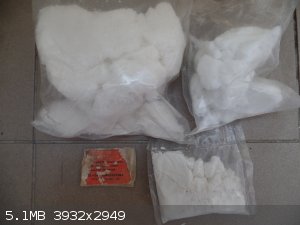
[Edited on 3-8-2016 by TheMrbunGee]
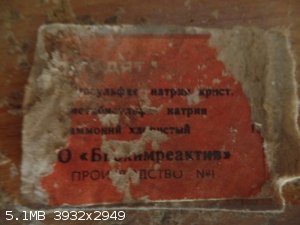
|
|
|
| Pages:
1
2
3
4
5 |